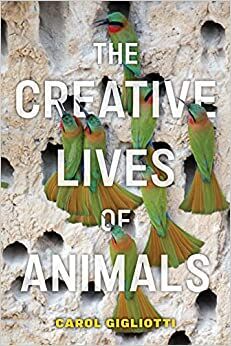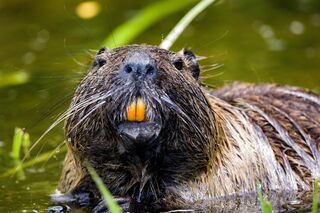Creativity
The Fascinating and Wide-Ranging Creative Lives of Animals
An essential new book weaves creativity into morality, play, and much more.
Posted November 22, 2022 Reviewed by Vanessa Lancaster
Key points
- Carol Gigliotti discusses creativity in diverse animals, from elephants to ants, and shows how they are unquestionably ingenious.
- Creativity among nonhumans shows they may have rich and deep cognitive, emotional, and moral lives.
- Intelligence and creativity come in many shapes and sizes, revealing new perspectives and purposes not previously accounted for.

When I first read the manuscript for Carol Gigliotti's eye-opening The Creative Lives of Animals, I took pages and pages of notes.1
Now that I've read it once again in print, I'm still taking copious notes. Carol's book is a game-changer. She shows how important creativity—improvisation and invention—is in a wide variety of contexts, including expressing different emotions, playing, socially communicating with others, courting, mating, and raising children, and designing and engineering animals' homes.
Science-based and easy to read, The Creative Lives of Animals will be of interest to a broad audience, including researchers and non-researchers alike, and surely will change how humans view and treat the fascinating animals with whom we share our magnificent planet.
Here's what Carol had to say about her landmark and highly original book.
Marc Bekoff: Why did you write The Creative Lives of Animals?
Carol Gigliotti: I was delighted to find an article and a book on animal innovation and creativity in the early 2000s. Here, I thought, were qualities, such as intelligence, emotion, or self-awareness, that humans could no longer assume did not exist in animals. However, two things within the research troubled me. One was the insistence on the word innovation instead of creativity.
As an artist and longtime teacher of creative processes, I experienced the difficulties caused when conflating those two concepts. A second issue for me was that the language used often limited the range of creativity documented and did not describe or recognize other qualities animals used in their creative processes.
In 2011, I received a grant to help organize a conference and exhibition called Animal Influence. My colleagues Julie Andreyev and Maria Lantin, whose organization Interactive Futures sponsored the event, and I invited interactive artists together with biologists, philosophers, sociologists, ethologists, landscape architects, and art historians, among others, to consider how animals influenced their work. For me, the fact that animals are creative was the major takeaway from that event.
MB: How does your book relate to your background and general areas of interest?
CG: The book relies on my 30 years of teaching the creative process to an array of students, both in age and discipline. The knowledge I gained from those experiences helped me argue that animals are indeed creative. Throughout my life as an artist and a scholar, my primary focus has been to help shift our negative relationships with animals.
My additional work in animation, digital media, and the philosophy of technology allowed me to travel through these disciplines while questioning their underlying attitudes toward creativity and ethics. My edited book, Leonardo's Choice: Genetic Technologies and Animals, focuses on how misunderstanding the differences between creativity and progress has had disastrous consequences for animals.
MB: Who is your intended audience?
CG: I wrote this book for a general audience. After many years of writing as a scholar about animals as victims, I wanted readers to envision animals as the creative and powerful beings they are. I used narrative to pull the reader into an individual animal's unique world so that they might empathize with the thinking, emotion, and judgment used by that animal in navigating a creative process. I think the book speaks to a wide range of people interested in animals, biodiversity, new conservation ideas that recognize the importance of individual animals, and a more comprehensive definition of creativity.
MB: What are some of the topics you weave into your book, and what are some of your major messages?
CG: The foundational topic is how animals use their intelligence, experience, emotion, and agency to communicate, play, build, make tools, choose and obtain their sexual partners to flourish in their worlds, and contribute to their cultural inheritance.

These are topics of ongoing research by biologists, ethologists, evolutionary biologists, comparative psychologists, conservation biologists, and neuroscientists, among others. I take the reader through a journey of discovery about how species from elephants to alligators and octopuses to ants use their unique creative qualities to accomplish these objectives.
An important message I hope readers take from the book is that we, too, need to be open, flexible, and comfortable with complexity, qualities associated with creative behavior. We need to exercise these qualities if we are to appreciate animals for who they are as individuals and understand how creativity is often an integral part of their everyday lives. From this in-depth exploration into the creativity of animals, another message emerges.
Previous conservation efforts to preserve biodiversity have been considered in genetic terms. Little thought was given to the loss of individual animals and their creative contributions to the families, groups, cultures, and habitats in which they flourish. Disregarding individual animals' creativity and its influence on the distinct cultures of animals across and within species as a significant driver of biodiversity offered limited successful conservation of both species and habitats, something desperately needed to fight climate change. Only recognizing this will open up new, creative paths to how we might stop the loss of biodiversity on our shared planet.
MB: How does your book differ from others concerned with some of the same general topics?
CG: Many of the general topics in the book have been the focus of many wonderful books already published. In focusing on the creative processes, I wanted to highlight the research in this area and tease out the many qualities of creativity I saw in research that was not focused on it. I concentrated on the creative process rather than on a result or a goal because, as any creative person will tell you, it is in the process that one is most open, flexible, curious, inventive, persistent, and comfortable with complexity. Even though that might seem impractical, it is important to remember that intelligence and creativity come in many shapes and sizes, revealing new perspectives and purposes not previously accounted for.
MB: Are you hopeful that as people learn more about creativity in a wide range of animals, they will respect and treat them better?
I have been hoping that people will respect and treat animals better for most of my life. I am hoping, with this book, they might see animals as individual creative beings who contribute to their own lives, their families, groups, cultures, species, and the biodiversity essential to the health of this planet.
References
In conversation with Carol Gigliotti. Carol is an author, artist, animal activist, and scholar whose work focuses on the reality of animals’ lives as important contributors to the biodiversity of this planet. She is Professor Emerita of Design and Dynamic Media and Critical and Cultural Studies at the Emily Carr University of Design, Vancouver, BC. Canada.
1) The book's description reads: Most of us view animals through a very narrow lens, seeing only bits and pieces of beings that seem mostly peripheral to our lives. However, whether animals are building a shelter, seducing a mate, or inventing a new game, animals’ creative choices affect their social, cultural, and environmental worlds. The Creative Lives of Animals offers readers intimate glimpses of creativity in the lives of animals, from elephants to alligators to ants. Drawing on a growing body of scientific research, Carol Gigliotti unpacks examples of creativity demonstrated by animals through the lens of the creative process, an important component of creative behavior, and offers new thinking on animal intelligence, emotion, and self-awareness. With examples of the elaborate dams built by beavers or the lavishly decorated bowers of bowerbirds, Gigliotti provides a new perspective on animals as agents in their own lives, as valuable contributors to their world and ours, and as guides in understanding how creativity may contribute to conserving the natural world. Presenting a powerful argument for the importance of recognizing animals as individuals and as creators of a healthy, biodiverse world, this book offers insights into both the established and emerging questions about the creativity of animals.
Gigliotti, Carol. Opinion: Biodiversity Loss Worsened by Extinguishing Animal Innovators. The Scientist, October 17, 2022.
The Creative Lives of Animals: An Interview with Carol Gigliotti. Culture & Animals Foundation, November 15, 2022.




